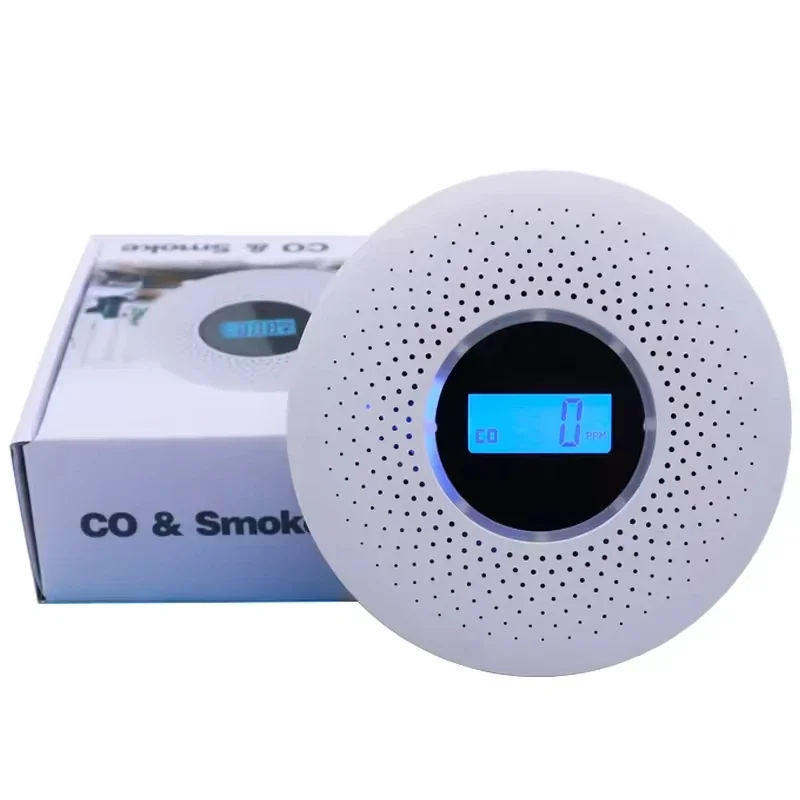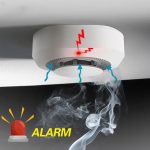Identifying the Cause of Beeping Smoke Alarms
When your smoke alarm beeps 3 times every 15 minutes, it’s a clear signal something’s wrong. It’s telling you to take action, but what kind? To determine the cause, follow these steps:
- Check for Smoke: Begin by looking for signs of smoke or fire. If you see or smell smoke, follow your fire escape plan and call 911.
- False Alarms: If there’s no smoke, consider common triggers. False alarms can occur from cooking smoke or even steam.
- Device Malfunctions: The alarm’s pattern may indicate a malfunction. Constant beeps suggest smoke detection, spaced-out beeps could mean a battery or device issue.
- Battery Check: If it’s a battery-powered alarm, examine the batteries. Ensure they’re installed properly and have power.
- End-of-Life Warning: Some alarms beep in patterns to signal the end of their lifespan. It might be time to replace your detector.
- Environmental Factors: Examine the alarm’s location. Is it near a window or kitchen? Temperature and humidity can affect its function.
- Press the Test Button: This can help you check if the alarm and batteries are working correctly.
By pinpointing the cause of the beeps, you can take the necessary steps to fix the issue. Regular maintenance and understanding your smoke alarm’s signals are key to ensuring your safety.

The Meaning Behind Different Smoke Alarm Beeps
Recognizing the different beeps from your smoke alarm is crucial. Each sound pattern can diagnose a specific issue. Here are common beep patterns and their meanings:
- Three Rapid Beeps: This usually means smoke or fire is detected. Act quickly by checking for signs of fire and evacuate if needed.
- Consistent Beeps Every Few Minutes: This indicates a possible malfunction. It could be a problem with the device or a dying battery. Perform a battery check and consider replacing the device if necessary.
- Single Chirp at Regular Intervals: Often signifies a low battery. Replace the batteries and test the alarm again.
- Irregular Beeping: Can suggest temperature or humidity issues. Ensure the alarm isn’t placed near windows, fans, or vents.
- End-of-Life Signal: Some alarms chirp in a pattern as a warning that they’re expiring. Consult the manual, and if needed, replace the unit.
Understanding these signals helps you maintain your smoke alarm and keep your home safe. Regular checks and prompt battery replacements can prevent most beeping issues.
Steps to Stop Your Smoke Alarm from Beeping
Smoke alarms are essential for safety, but a beeping alarm can be distressing. Here’s how to stop it:
- Replace the Batteries: If your smoke alarm beeps 3 times every 15 minutes, it could mean low batteries. Change them right away to silence the beep.
- Reposition the Alarm: Move your smoke detector away from places that can cause false alarms. Avoid kitchens, bathrooms, windows, and vents.
- Clean the Detector: Dust and insects can trigger beeping. Open the alarm and gently wipe the inside with a soft brush or cloth.
- Press the Test Button: After changing batteries, press this button. This checks that your smoke alarm is working well.
- Reset the Alarm: Still beeping after new batteries? Try a hard reset. Turn off power, remove the alarm, press ‘test’ to drain residual charge, then reinstall.
- Check for Interferences: Make sure the smoke alarm isn’t near temperature extremes or humidity. Such environment factors can make it beep unnecessarily.
- Replace the Unit: If your alarm is old or continues to beep after these steps, it may be time to get a new one. Check the date and replace an alarm more than ten years old.
- Seek Professional Help: If problems persist, contact a professional. They can diagnose and fix complex issues with hard-wired systems.
Regular upkeep stops your smoke alarm from making unwanted noise and ensures it works in an emergency.
The Impact of Battery Issues on Smoke Alarms
Battery problems are a common cause of smoke alarm issues. When your smoke alarm beeps 3 times every 15 minutes, it often points to a battery issue. Below are critical impacts battery issues can have on your smoke alarm’s performance:
- Low Battery Power: A weak or dying battery can fail to power the alarm’s sensor properly. This can result in irregular beeping patterns. Change batteries as soon as you hear beeps at regular intervals.
- Improper Battery Installation: If batteries are not inserted correctly, the alarm may fail to operate. Ensure batteries are installed with the correct orientation and fully secured in place.
- Battery Corrosion: Over time, batteries may leak and cause corrosion. This can damage the alarm’s connections, leading to malfunctions. Check and clean battery terminals regularly to prevent this.
- Life Span of Batteries: Batteries do not last forever. They need replacement at least once a year, or as recommended by the manufacturer. Always use the specified battery type for your alarm.
- Battery Removal: Removing batteries to silence nuisance alarms is dangerous. It leaves your home unprotected. Instead, locate the cause of false alarms and address it promptly.
- Expired Batteries: Using old batteries puts your safety at risk. Always check battery expiry dates before use and stock up on fresh ones.
Remember, a well-maintained smoke alarm with fresh batteries is critical for your safety. Test your smoke alarm monthly, and replace batteries diligently to maintain its reliability.

How Environmental Factors Influence Smoke Alarm Function
Environmental factors play a key role in how smoke alarms operate. Temperature, humidity, and airflow can all impact functionality, potentially leading to false alarms or malfunctions.
Temperature and Smoke Alarms
Smoke alarms may react to extreme heat or cold. Too-hot or too-cold conditions can cause devices to beep unnecessarily. Always install alarms away from sources that fluctuate in temperature, like ovens or heaters.
Humidity’s Impact
High humidity can mimic the dense air of smoke, prompting false alarms. Place smoke detectors in areas with stable humidity levels, not too close to bathrooms or kitchens where steam is common.
Airflow and Sensor Sensitivity
Air circulation from windows, fans, or vents can disrupt smoke alarm sensors. Unusual airflow may lead to irregular beeping. Avoid positioning alarms near these elements to ensure accurate detection.
By understanding these environmental effects, homeowners can better locate smoke alarms to avoid issues. Reduce false alarms by keeping detectors in optimal conditions away from temperature changes, humidity, and strong airflow. Always check alarm locations and move them if needed to prevent malfunctions.

Recognizing End-of-Life Signals from Your Smoke Detector
Recognizing when your smoke detector is nearing the end of its life is crucial for maintaining its effectiveness. Here are the key signals to watch out for:
Loud and Consistent Chirping
A smoke alarm beeps 3 times every 15 minutes, most commonly indicating serious issues, often a fire. But what should you do if it chirps consistently and there’s no smoke or fire present? This may indicate that your smoke alarm is at the end of its lifecycle. Continuous chirping not induced by smoke or environmental factors means it’s time to replace the unit.
Sporadic Beeping
If a smoke detector emits random chirps, it could be a sign of a malfunction rather than environmental triggers or smoke. Replace the batteries to see if it resolves the issue. If the chirping persists, the smoke detector likely needs replacing.
Single Chirp at Regular Intervals
A single chirp at regular intervals, such as one beep per minute, can signify that the smoke alarm detects a battery problem or it’s reaching its end. Check and replace the batteries if necessary. If the problem continues, consider replacing the smoke alarm.
Regular maintenance and awareness of the lifespan of your smoke detector are essential. Replace smoke detectors every ten years, or as recommended by the manufacturer. Testing them monthly and replacing batteries annually will ensure they function properly when needed. Always consult the user manual for specific guidance on your model.
Understanding Hard-Wired vs. Battery-Operated Smoke Alarms
Choosing the right type of smoke alarm for your home can significantly enhance your safety. Let’s explore the differences between hard-wired and battery-operated smoke alarms to help you make an informed decision.
Hard-Wired Smoke Alarms
Hard-wired smoke alarms connect directly to your home’s electrical system. They have several key benefits:
- Constant Power Supply: They operate off your home’s electricity, ensuring continuous protection.
- Interconnected System: Most models can link with other alarms in the home. If one detects smoke, all alarms will sound, providing widespread alerts.
- Less Maintenance: You don’t need to replace batteries regularly, which saves time and effort. However, it’s good to have a battery backup for power outages.
- Professional Installation Required: Installation by a qualified technician is necessary, which can add to the cost.
Battery-Operated Smoke Alarms
Battery-operated smoke alarms are standalone units powered by batteries. Here are their advantages:
- Easy Installation: You can install these alarms yourself. Place them anywhere in your home.
- Flexibility: Ideal for areas without electrical wiring. They work during power outages.
- Regular Maintenance Needed: You must check and replace the batteries periodically to ensure functionality.
- Affordable: These units are generally less expensive than hard-wired models.
Both types of smoke alarms are effective but cater to different needs. Hard-wired models offer reliability and connectivity, which suits larger homes. Battery-operated models offer simplicity and are easier to install, making them ideal for smaller homes or apartments. Consider your home’s layout and your personal preferences when choosing your smoke alarms. Always ensure that whichever type you choose, it meets the safety standards and requirements necessary for optimal protection.
Regular Maintenance to Prevent Unnecessary Chirping
Keeping your smoke alarm in good condition can prevent annoying chirps. Follow these steps for regular maintenance:
- Test Your Smoke Alarm Monthly: Press the test button to ensure it works correctly.
- Change Batteries Regularly: Swap out old batteries every six months, or earlier if it beeps.
- Clean the Alarm: Dust off your smoke alarm every few months to keep it clear of debris.
- Update Alarm Locations: Shift detectors away from humidity, extreme temperatures, and airflow disruptions.
- Replace Old Smoke Alarms: Get a new alarm if yours is older than ten years or continues to chirp after troubleshooting.
By following these simple steps, you can keep your smoke alarm ready to alert you in case of fire, without unnecessary noise.


